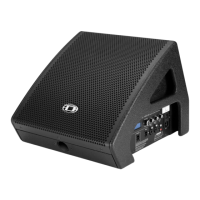Troubleshooting
Avoid acoustical feedback
Several circumstances and conditions have an influence on how sensitive or insensitive your
system is for acoustical feedback. The following notes are meant to assist you in avoiding
feedback and you should take them into consideration even before you activate the feedback
filter.
Best practice for avoiding feedback
1. Do not position the main speaker systems behind the microphones.
2. Switch off all microphones that are not in use.
3. Consider the microphones’ different polar patterns and characteristics, when placing the
monitor speakers.
4. Do not turn up the monitor system’s volume higher than actually necessary.
5. Try to avoid extensive equalization on channels that you want to include in your monitor
mix.
6. Keep in mind, that a microphone “behaves” differently when somebody stands right in
front of it.
7. Position the microphones as directly as possible to the sound source.
Using the feedback filter
If you still have the feeling that the monitor system’s acoustic output is not sufficient, after
considering the above mentioned precautions, you can use the feedback filter to mute the
frequency that tends to generate feedback the most.
Therefore, you have to perform the following steps:
1. Increase the INPUT 1/2 level until the limit is reached where feedback starts. The slightly
“hovering” sound that you hear is generated by the system itself.
2. Select the menu item Feedback, by default the feedback filter is deactivated (“Off”).
3. Turn the MENU/ENTER rotary encoder to activate the feedback filter and set the filter to
the frequency where the “sound” disappears.
The feedback filter attenuates the level of the corresponding frequency band by about 10 dB.
Since the filtered band is extremely narrow, an alteration in the sound of your monitor system
is hardly audible.
Caution!
Please be extremely careful in driving the system just below the feedback limit. Careless
operation, resulting in feedback noise at high SPL, can cause severe damage to your speaker
systems and – even more important – the human ear.
Replace a blown fuse
First, turn off the power of the unit and pull the mains plug. Then, open the cover next to the
mains socket to replace the blown fuse. Only use following fuse type: 5x20 mm, 250 V, 4 A
8
8.1
8.2
16 en | Troubleshooting AXM 12A
18-Mar-14 | 02 | F01U290507 User manual Bosch Sicherheitssysteme GmbH

